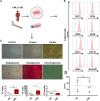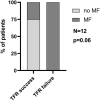Myelofibrosis at diagnosis is associated with the failure of treatment-free remission in CML patients
- PMID: 37469867
- PMCID: PMC10352620
- DOI: 10.3389/fphar.2023.1212392
Myelofibrosis at diagnosis is associated with the failure of treatment-free remission in CML patients
Abstract
The management of patients with chronic myeloid leukemia (CML) has been revolutionized by the introduction of tyrosine kinase inhibitors (TKIs), which induce deep molecular responses so that treatment can eventually be discontinued, leading to treatment-free remission (TFR) in a subset of patients. Unfortunately, leukemic stem cells (LSCs) often persist and a fraction of these can again expand in about half of patients that attempt TKI discontinuation. In this study, we show that presence of myelofibrosis (MF) at the time of diagnosis is a factor associating with TFR failure. Fibrotic transformation is governed by the action of several cytokines, and interestingly, some of them have also been described to support LSC persistence. At the cellular level, these could be produced by both malignant cells and by components of the bone marrow (BM) niche, including megakaryocytes (MKs) and mesenchymal stromal cells (MSCs). In our cohort of 57 patients, around 40% presented with MF at diagnosis and the number of blasts in the peripheral blood and BM was significantly elevated in patients with higher grade of MF. Employing a CML transgenic mouse model, we could observe higher levels of alpha-smooth muscle actin (α-SMA) in the BM when compared to control mice. Short-term treatment with the TKI nilotinib, efficiently reduced spleen weight and BCR::ABL1 mRNA levels, while α-SMA expression was only partially reduced. Interestingly, the number of MKs was increased in the spleen of CML mice and elevated in both BM and spleen upon nilotinib treatment. Analysis of human CML-vs healthy donor (HD)-derived MSCs showed an altered expression of gene signatures reflecting fibrosis as well as hematopoietic support, thus suggesting MSCs as a potential player in these two processes. Finally, in our cohort, 12 patients qualified for TKI discontinuation, and here we observed that all patients who failed TFR had BM fibrosis at diagnosis, whereas this was only the case in 25% of patients with achieved TFR, further supporting the link between fibrosis and LSC persistence.
Keywords: CML; LSC; MSc; TFR; fibrosis; leukemic stem cells.
Copyright © 2023 Jacobi, Vieri, Bütow, Namasu, Flüter, Costa, Maié, Lindemann-Docter, Chatain, Beier, Huber, Wagner, Crysandt, Brümmendorf and Schemionek.
Conflict of interest statement
TB served as a consultant or speaker at satellite symposia for AstraZeneca, Janssen, Merck, Novartis and Pfizer and received research funding form Novartis and Pfizer. The remaining authors declare that the research was conducted in the absence of any commercial or financial relationships that could be construed as a potential conflict of interest.
Figures





Similar articles
-
Leukemic stem cells shall be searched in the bone marrow before "tyrosine kinase inhibitor-discontinuation" in chronic myeloid leukemia.Int J Lab Hematol. 2021 Oct;43(5):1110-1116. doi: 10.1111/ijlh.13528. Epub 2021 Apr 9. Int J Lab Hematol. 2021. PMID: 33834631
-
Prospective monitoring of chronic myeloid leukemia patients from the time of TKI discontinuation: the fate of peripheral blood CD26+ leukemia stem cells.Front Pharmacol. 2023 May 26;14:1194712. doi: 10.3389/fphar.2023.1194712. eCollection 2023. Front Pharmacol. 2023. PMID: 37305536 Free PMC article.
-
Residual Peripheral Blood CD26+ Leukemic Stem Cells in Chronic Myeloid Leukemia Patients During TKI Therapy and During Treatment-Free Remission.Front Oncol. 2018 May 30;8:194. doi: 10.3389/fonc.2018.00194. eCollection 2018. Front Oncol. 2018. PMID: 29900128 Free PMC article.
-
Immune Effector Recovery in Chronic Myeloid Leukemia and Treatment-Free Remission.Front Immunol. 2017 Apr 24;8:469. doi: 10.3389/fimmu.2017.00469. eCollection 2017. Front Immunol. 2017. PMID: 28484463 Free PMC article. Review.
-
Treatment-free remission after discontinuation of imatinib, dasatinib, and nilotinib in patients with chronic myeloid leukemia.Blood Res. 2023 Apr 30;58(S1):S58-S65. doi: 10.5045/br.2023.2023035. Epub 2023 Apr 7. Blood Res. 2023. PMID: 37026381 Free PMC article. Review.
Cited by
-
A nomogram for predicting T315I-free survival in chronic phase chronic myeloid leukemia patients: a multicenter retrospective study.Sci Rep. 2025 Feb 18;15(1):5965. doi: 10.1038/s41598-025-89851-y. Sci Rep. 2025. PMID: 39966463 Free PMC article.
-
Telomere Length Is Associated With Adverse Atrial Remodeling in Patients With Atrial Fibrillation.J Am Heart Assoc. 2025 Feb 4;14(3):e037512. doi: 10.1161/JAHA.124.037512. Epub 2025 Feb 3. J Am Heart Assoc. 2025. PMID: 39895528 Free PMC article.
References
-
- Aggoune D., Sorel N., Bonnet M. L., Goujon J. M., Tarte K., Hérault O., et al. (2017). Bone marrow mesenchymal stromal cell (MSC) gene profiling in chronic myeloid leukemia (CML) patients at diagnosis and in deep molecular response induced by tyrosine kinase inhibitors (TKIs). Leuk. Res. 60, 94–102. 10.1016/j.leukres.2017.07.007 - DOI - PubMed
LinkOut - more resources
Full Text Sources
Molecular Biology Databases
Miscellaneous

